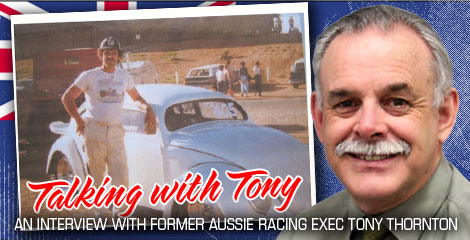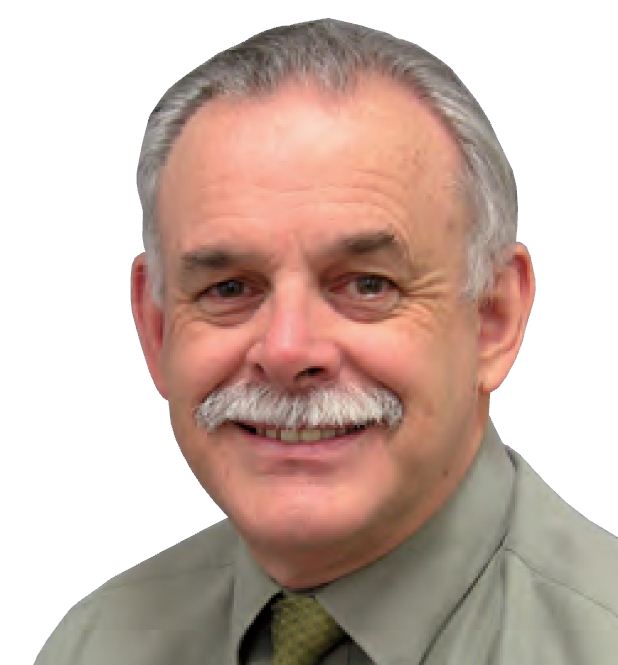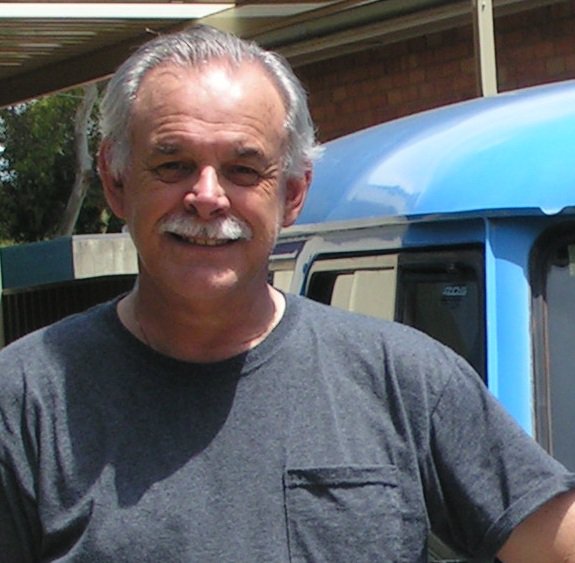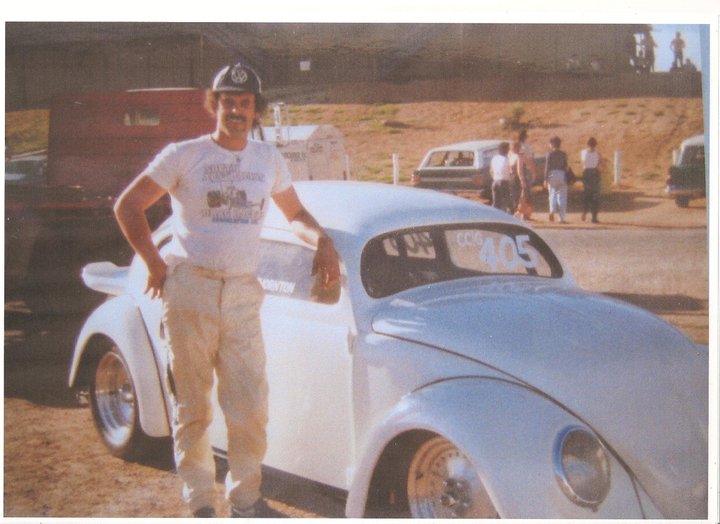INTERVIEW: TALKING WITH TONY THORNTON
 On July 1, Tony Thornton, CEO of the Australian National Drag Racing Association [ANDRA], announced his retirement from the country's leading sanctioning body.
On July 1, Tony Thornton, CEO of the Australian National Drag Racing Association [ANDRA], announced his retirement from the country's leading sanctioning body.
A former national record holder and Divisional Director in South Australia, Thornton ascended into the leadership role in 1988. Many credit Thornton's leadership style for a revival of the sport, which at the time, had fallen on hard times.
Thornton, 23 years later, leaves the executive world of drag racing world just as the sport Down Under faces more than its share of issues presently.
CompetitionPlus.com recently discussed with Thornton his time as the leader, his feelings of the sport's controversy and life after retirement.
 On July 1, Tony Thornton, CEO of the Australian National Drag Racing Association [ANDRA], announced his retirement from the country's leading sanctioning body.
On July 1, Tony Thornton, CEO of the Australian National Drag Racing Association [ANDRA], announced his retirement from the country's leading sanctioning body.
A former national record holder and Divisional Director in South Australia, Thornton ascended into the leadership role in 1988. Many credit Thornton's leadership style for a revival of the sport, which at the time, had fallen on hard times.
Thornton, 23 years later, leaves the executive world of drag racing world just as the sport Down Under faces more than its share of issues presently.
CompetitionPlus.com recently discussed with Thornton his time as the leader, his feelings of the sport's controversy and life after retirement.
CP – You provided ANDRA with 23 years of your life, what do you plan to do with the next 23?
TT – I don’t know about the next 23, but I am going to have the next two or three months off. It’s been fairly hectic over the last six or seven months as ANDRA has gone through some changes. I’ll get some other things done that have been left wanting.
CP – What are you most proud of in your tenure as the leader of ANDRA?
TT – It goes back a long way. When things began for me, it was a fairly tough time. ANDRA has some financial issues. There were a few other things going on with some of the tracks. Over a period of time, we resolved those. Then we moved through the 1990s and we bought our new offices. We went from having two people in the office to seven.
Over the last three or four years, we’ve been able to develop the [ANDRA] PRO Series with the television. The product of drag racing has grown a fair bit since the early days with the additional categories. There aren’t many things that ANDRA has ever cut out. We just kept adding good things, so we pretty much had everything we started with.
CP – What is the one thing during your time as the leader which disappoints you the most?
TT – The electronic opportunities has increased websites and forums. The amazing amount of negativity that you get from people who won’t tell you what their name is. I think that’s a factor in many things now as the social media increases and people have the opportunity to offer an opinion. To a degree that is good, but you can certainly get overwhelmed by the negative stuff. As with most things, people don’t tend to highlight the positives anymore.
CP – There are those Down Under who will say drag racing in Australia is in dire straits. However, in an interview with DRAGSTER Australia, you say that you’re leaving a financially sound ANDRA. Is this the case?
TT – Absolutely, we have fairly good cash reserves. We own out offices in Adelaide. From that point of view, an administrative one if you like, it is fine. Certainly the climate in Australia and I could talk about that as well, the weather this season and going back to the middle of last year has been challenging. We’ve probably seen more rain than we have in the last eight to ten years. We had some events badly affected by the weather, most recently the Winter Nationals which was due for completion last weekend. We made it down to the finals. This year’s Winter Nationals won’t go down as one of the more memorable.
At the same time, while Australia weathered the global financial crisis and we did fairly well. A lot of people now are careful with spending their money. It’s very obvious in the retail area. People aren’t spending as much as they might. Certainly when you are talking entertainment and motorsports, that probably comes down before a few other things. We’ve seen a decline in the spectator numbers. It’s not just drag racing. It’s a whole lot of other things. That has got to be carefully assessed and managed.
CP – If the sanctioning body is financially sound as ANDRA is, why is the morale of the Group 1 racers so bad?
TT – In Australia, Group 1 Racing has six pro categories, is extremely expensive. You can’t get parts as quickly unless you are prepared to spend the money. Parts are generally more expensive. The balance between the Australian and the U.S. Dollar is pretty good now for the Australians. That’s a bonus.
It’s very interesting. When we started the ANDRA Pro Series, part of the plan was for the Group 1 teams to become a little more self-sufficient in funding and resources. The television we’ve provided was intended to be the first step in that. It’s certainly made things more commercially viable for those teams who choose to go out and look for more commercial backing. That didn’t happen anywhere to the same extent that was expected. Part of that could be due to the economic situation in the country. But, then again, there are some people who don’t like to do drag racing as a job, I suppose because it is a hobby. It is very expensive. I suspect a lot of people want to treat it like it is a hobby.
CP – In an article recently published in CompetitionPlus.com, some of the racers express their feelings ANDRA has essentially sold out to Drag Ltd. In your opinion, was ANDRA a follower of Drag Ltd., or filling the role of a good partner?
TT – We were a supporter and it was a joint venture between the three major tracks and ANDRA. There’s no way the concept could have moved forward without the tracks on our side. The whole thing was done as a cooperative. Some of the things that are emerging now suggest it might go in another direction. My priority was that we did everything that was possible to make sure the tracks were viable. That’s been a challenge for a while. From there, there would be guaranteed places for sportsman racers and sportsman events.
From an ANDRA point of view, and my view as the CEO, that was the high priority. Some of the options now, do not to include the sportsman racers, and while the sport looks very similar in Australia, many of our sportsman racers feel as big of a part of the national events as the Group 1 racers do. I intended to sustain that as far as possible.
CP – Now that you’re outside of ANDRA, the Phil Lamattina proposed series, will it work or fail?
TT – To be honest with you, I’m not sure. The last meeting I had with the Lamattina people and Drag Ltd., which was only late June, they didn’t have a plan. I suggested [to them] the better approach if they had better ideas or resources, was for everyone to work together. But … it required the support of the tracks, and at that time, some four weeks ago, there was nothing to put on the table. I’m sure they are working fairly hard on that. Certainly, whatever happens I’m concerned that the priority remains for the whole of drag racing and not just the bit at the top.
CP – Obviously, one of the toughest situations you had to deal with was the fallout with Bob Jane and losing his tracks. What exactly happened there?
TT – We had a great relationship with Bob Jane. Ironically, the day I started the job officially, in September of 1988, I had a call from Melbourne saying that Bob Jane had decided to step away from ANDRA and run his own drag racing. We worked hard over the next three to four months, and we resolved those issues. Bob Jane also owned the track in Adelaide where I live and ANDRA is based. It was more important than just one city. We began with events and Bob ran ANDRA in the early 1990s and that led to our Australian events being long term there. We ran there from 1992 until 2001. Through that period, it wasn’t the easiest of relationships but the result was always good.
In the end, Bob decided he didn’t want to run ANDRA drag racing events anymore. Subsequently, a few weeks later he told us he didn’t want to run the 2001 Nationals. ANDRA stepped in and brought people in from all over the country and made the event run. It was the first time in a decade the event had been affected by weather but it certainly demonstrated what ANDRA is capable of. From that point, there was no ANDRA activity of any kind at Calder Park in Melbourne or at Adelaide International Raceway. That issue has never been resolved. The Adelaide track is certainly is some level of disrepair. We have been working with groups in Adelaide or Melbourne to pursue new venues.
CP – In the article published recently in CompetitionPlus.com, ANDRA was typecast as weak. Do you agree or disagree with that assessment?
TT – It all depends on the way you see the sanctioning body’s role. Unlike some of the events in the U.S., ANDRA doesn’t run the events. The tracks do. They fund the events and take the risks, less now than in the past. They generate a good return but now the weather is always a risk as it is everywhere. We don’t have the opportunities to rerun events. The completion of the Winter Nationals was a convenient day that was available. Once, in the past, the Winter Nationals was postponed from June until October, the year the Olympics was in Australia. Other than that, ANDRA is not a promoter at all. It wasn’t intended to be [a promoter] in the past. Some of the changes that has been recently made, to a company structure, do offer the organization the opportunity to do that now. At the end of the day, I think ANDRA has had a fairly good relationship with the promoters who have supported ANDRA. That needs to continue because the business of running the tracks has traditionally been the business of the people we call the promoters, the managers and operators. For that to change, it’s a fairly big change. Any organization can be turned around to do those things. It’s just a matter of how that occurs.
CP – Let’s say, you have a youthful aspiring executive and his goal is to be the head of a sanctioning body. Having been in that position, do you advise them to [a] pursue your dreams or [b] run as fast as you can away from this idea?
TT – Personally, I’d advise them to chase the dream. I am what we call a drag racing tragic. There are lots of other people in this sport who are tragics. You have to be careful that it doesn’t blind you to some of the other obvious challenges that you cannot ignore. At the end of the day, I think you need a lot of business in the sport. But, you also need a bit of the sport in your business.
CP – How are you going to remain retired when you were such an admitted hands-on leader?
TT – I’m sort of forcing myself not to worry about that for a few months. While I did “retire”, and that was the word we used, I don’t intend to retire from life. Certainly, I still want to be a drag racing fan, and be around the sport, in the short term, I am just going to take a break. In September and October, I will start looking at my options.
CP – Becoming a driver again one of those options?
TT – I’ll say this. I gave up racing in 1982, and after a crash in 1982, I realized there were less stressful ways of following the dream. I walk around the pits, and from looking at the pros down to the sportsman racers, the commitment is much larger than it was back then. I might not drive again, but I won’t be a stranger to the sport.
| {loadposition feedback} |




